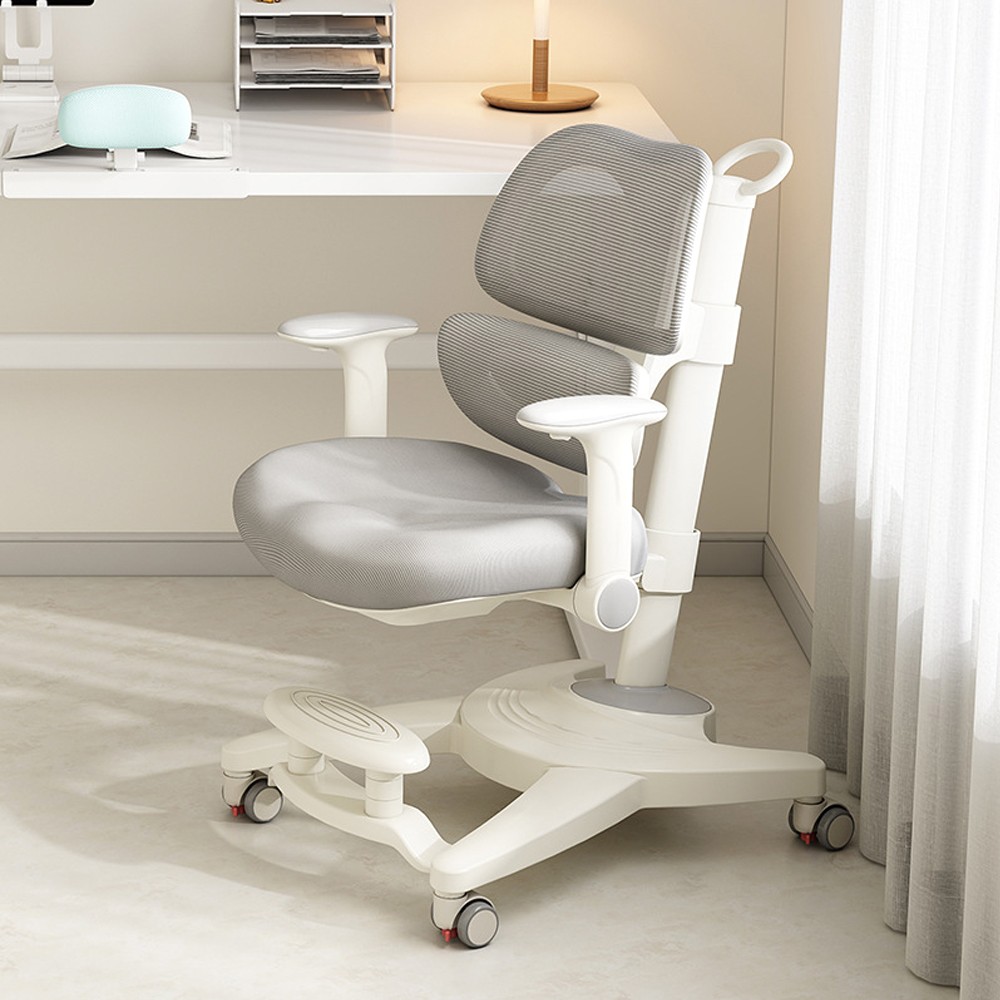
Here are the key ergonomic design considerations for children, tailored to their developmental characteristics, body dimensions, and behavioral habits. These principles aim to ensure comfort, promote proper posture, and reduce health risks during learning and activities:
I. Body Support and Posture Guidance Design
1. Spinal and Back Support
· Dual-back Partition Support: Using a split backrest design to conform to the lumbar curve (mimicking the natural "C" shape), distributing spinal pressure and preventing lower back suspension during prolonged sitting. Some study chairs feature independent dual-back structures that automatically adjust support angles with the child's movements.
· Sacral Support: A forward-protruding support at the lower backrest targets the sacrum, maintaining the lumbar curve and preventing slouching.
· Ergonomic Backrest Curvature: The backrest curve should fit the child's back, with the upper edge reaching the mid-scapula to provide uniform support for the entire back.
2. Posture Guidance Structure
· Slightly Tilted Seat Cushion: The front edge of the cushion tilts up by 5°–10°, encouraging the thighs to incline naturally, reducing hip sliding, and helping maintain a 90° knee angle.
· Lumbar Protrusion Support: A forward bulge in the middle of the backrest supports the lumbar muscles, preventing slouching due to fatigue.
II. Adjustable Design (Adapting to Growth)
1. Height Adjustability
· Seat Height Adjustment: Adjust via a gas lift or knob to ensure the child’s feet rest flat on the floor with 90° knee flexion, avoiding leg fatigue from dangling. The recommended range is 28–45 cm (suitable for 3–12-year-olds).
· Backrest Height Adjustment: The backrest slides up/down to keep the support point aligned with the lower scapula, adapting to height growth.
· Desk Height Linkage: Pair with an adjustable desk to maintain a height where the elbow rests naturally (desk height = elbow height when seated).
2. Depth and Width Adjustability
· Seat Depth Adjustment: Slide the cushion forward/backward to ensure the back 1/3 of the thigh contacts the seat, avoiding pressure behind the knees (adjustment range: 29–39 cm).
· Armrest Width Adjustment: Adjustable armrests fit different shoulder widths, preventing shoulder tension from inward or outward arm positioning.
III. Comfort and Safety Details
1. Materials and Touch
· Seat Cushion Materials: Use high-density foam or latex combined with breathable mesh (e.g., a three-layer structure: mesh for cooling, latex for cushioning, foam for support) to balance support and breathability.
· Backrest Breathability: Materials like DuPont mesh or breathable fibers prevent back sweating and maintain dryness in summer.
2. Safety Protection Design
· Anti-tip Structure: A five-star base with large non-slip foot pads is more stable than a four-leg design. Chairs with wheels should have gravity-locking casters (wheels lock automatically when the child sits down).
· Anti-pinch Mechanisms: Adjustment components (e.g., backrest/seat height levers) must have protective covers or damping structures to prevent finger injuries (complying with the 2024 General Technical Conditions for Children's Furniture standard).
· Rounded Edges: All edges of the backrest, armrests, and seat cushion use arc chamfers to avoid injuries.
IV. Dynamic Activity Adaptation (Balancing Play and Study)
1. Recline Adjustment
· The backrest supports 15°–30° recline with locking, allowing the child to lean back for relaxation during reading or breaks (e.g., the 15° recline function in the Yongyi Little E study chair).
2. Lightweight and Mobility
· Chair weight is controlled at 5–8 kg for easy child movement. Universal casters should glide smoothly but not slip, balancing activity and stability.
V. Visual and Psychological Guidance Design
1. Color and Shape Appeal
· Use vibrant colors (e.g., blue, yellow) or cartoon elements to attract children and encourage voluntary use, avoiding resistance to monotonous designs.
2. Size Proportions for Child Psychology
· The chair’s dimensions are scaled to children’s body proportions (e.g., armrest height, seat width), creating a "personalized feel" and reducing discomfort from using adult furniture.
VI. Scenario-based Design (Learning, Drawing, Reading, etc.)
1. Multifunctional Accessories
· Include foldable small tabletops or drawing board brackets to suit activities like painting and crafts. Some chairs have detachable armrests for easy or desk access.
2. Height-Scenario Linkage
· Reading nook chairs can have a lower seat height (25–30 cm) with a low coffee table, suitable for cross-legged or kneeling reading, while study chairs follow the standard "desk-chair height difference of 25–30 cm".
Conclusion: Core Design Logic
Children’s ergonomic design centers on "dynamic adaptation to growth"—using adjustable structures for height changes, partitioned support for skeletal development, safety details to avoid risks, and child psychology to enhance usability. When purchasing, prioritize three dimensions: adjustment range, spinal support structure, and material safety to ensure the design truly serves the child’s healthy development.

